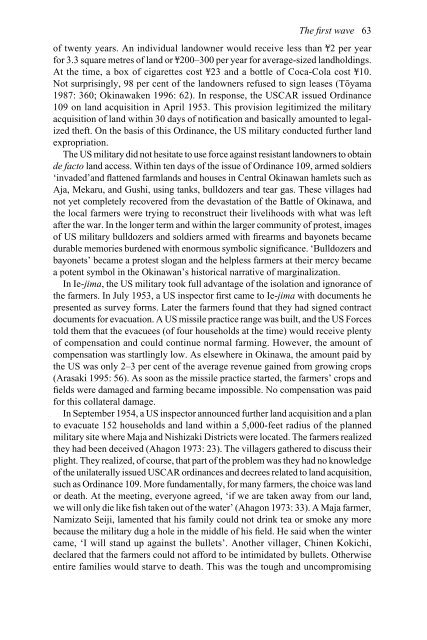Myth, Protest and Struggle in Okinawa
Myth, Protest and Struggle in Okinawa
Myth, Protest and Struggle in Okinawa
Create successful ePaper yourself
Turn your PDF publications into a flip-book with our unique Google optimized e-Paper software.
The first wave 63<br />
of twenty years. An <strong>in</strong>dividual l<strong>and</strong>owner would receive less than ¥2 per year<br />
for 3.3 square metres of l<strong>and</strong> or ¥200–300 per year for average-sized l<strong>and</strong>hold<strong>in</strong>gs.<br />
At the time, a box of cigarettes cost ¥23 <strong>and</strong> a bottle of Coca-Cola cost ¥10.<br />
Not surpris<strong>in</strong>gly, 98 per cent of the l<strong>and</strong>owners refused to sign leases (Tōyama<br />
1987: 360; Ok<strong>in</strong>awaken 1996: 62). In response, the USCAR issued Ord<strong>in</strong>ance<br />
109 on l<strong>and</strong> acquisition <strong>in</strong> April 1953. This provision legitimized the military<br />
acquisition of l<strong>and</strong> with<strong>in</strong> 30 days of notification <strong>and</strong> basically amounted to legalized<br />
theft. On the basis of this Ord<strong>in</strong>ance, the US military conducted further l<strong>and</strong><br />
expropriation.<br />
The US military did not hesitate to use force aga<strong>in</strong>st resistant l<strong>and</strong>owners to obta<strong>in</strong><br />
de facto l<strong>and</strong> access. With<strong>in</strong> ten days of the issue of Ord<strong>in</strong>ance 109, armed soldiers<br />
‘<strong>in</strong>vaded’<strong>and</strong> flattened farml<strong>and</strong>s <strong>and</strong> houses <strong>in</strong> Central Ok<strong>in</strong>awan hamlets such as<br />
Aja, Mekaru, <strong>and</strong> Gushi, us<strong>in</strong>g tanks, bulldozers <strong>and</strong> tear gas. These villages had<br />
not yet completely recovered from the devastation of the Battle of Ok<strong>in</strong>awa, <strong>and</strong><br />
the local farmers were try<strong>in</strong>g to reconstruct their livelihoods with what was left<br />
after the war. In the longer term <strong>and</strong> with<strong>in</strong> the larger community of protest, images<br />
of US military bulldozers <strong>and</strong> soldiers armed with firearms <strong>and</strong> bayonets became<br />
durable memories burdened with enormous symbolic significance. ‘Bulldozers <strong>and</strong><br />
bayonets’ became a protest slogan <strong>and</strong> the helpless farmers at their mercy became<br />
a potent symbol <strong>in</strong> the Ok<strong>in</strong>awan’s historical narrative of marg<strong>in</strong>alization.<br />
In Ie-jima, the US military took full advantage of the isolation <strong>and</strong> ignorance of<br />
the farmers. In July 1953, a US <strong>in</strong>spector first came to Ie-jima with documents he<br />
presented as survey forms. Later the farmers found that they had signed contract<br />
documents for evacuation. A US missile practice range was built, <strong>and</strong> the US Forces<br />
told them that the evacuees (of four households at the time) would receive plenty<br />
of compensation <strong>and</strong> could cont<strong>in</strong>ue normal farm<strong>in</strong>g. However, the amount of<br />
compensation was startl<strong>in</strong>gly low. As elsewhere <strong>in</strong> Ok<strong>in</strong>awa, the amount paid by<br />
the US was only 2–3 per cent of the average revenue ga<strong>in</strong>ed from grow<strong>in</strong>g crops<br />
(Arasaki 1995: 56). As soon as the missile practice started, the farmers’ crops <strong>and</strong><br />
fields were damaged <strong>and</strong> farm<strong>in</strong>g became impossible. No compensation was paid<br />
for this collateral damage.<br />
In September 1954, a US <strong>in</strong>spector announced further l<strong>and</strong> acquisition <strong>and</strong> a plan<br />
to evacuate 152 households <strong>and</strong> l<strong>and</strong> with<strong>in</strong> a 5,000-feet radius of the planned<br />
military site where Maja <strong>and</strong> Nishizaki Districts were located. The farmers realized<br />
they had been deceived (Ahagon 1973: 23). The villagers gathered to discuss their<br />
plight. They realized, of course, that part of the problem was they had no knowledge<br />
of the unilaterally issued USCAR ord<strong>in</strong>ances <strong>and</strong> decrees related to l<strong>and</strong> acquisition,<br />
such as Ord<strong>in</strong>ance 109. More fundamentally, for many farmers, the choice was l<strong>and</strong><br />
or death. At the meet<strong>in</strong>g, everyone agreed, ‘if we are taken away from our l<strong>and</strong>,<br />
we will only die like fish taken out of the water’ (Ahagon 1973: 33). A Maja farmer,<br />
Namizato Seiji, lamented that his family could not dr<strong>in</strong>k tea or smoke any more<br />
because the military dug a hole <strong>in</strong> the middle of his field. He said when the w<strong>in</strong>ter<br />
came, ‘I will st<strong>and</strong> up aga<strong>in</strong>st the bullets’. Another villager, Ch<strong>in</strong>en Kokichi,<br />
declared that the farmers could not afford to be <strong>in</strong>timidated by bullets. Otherwise<br />
entire families would starve to death. This was the tough <strong>and</strong> uncompromis<strong>in</strong>g
















